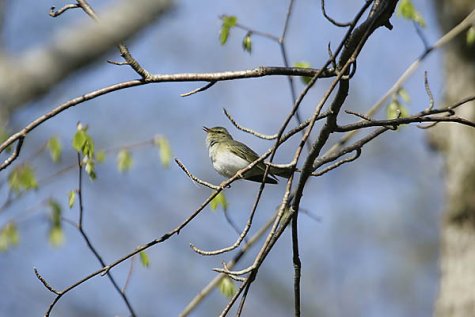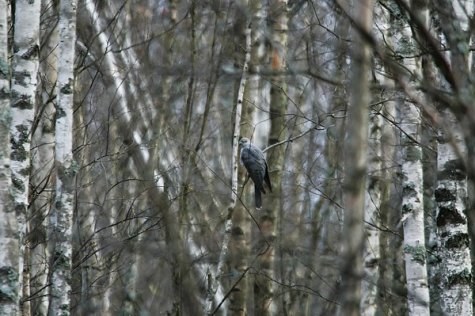Forest birds and their song - wood warbler
Audios and descriptions: Veljo Runnel, www.loodusheli.ee
Observations table and logic: Vello Keppart
Photos: Arne Ader
Translation: Liis
| Wood warbler | Mets-lehelind |
The wood warbler has a very characteristic song, an accelerating twitter like a ping-pong ball dropped on to a table. The song ends with a constant twitter. Into the song it sometimes slips plaintive whistling calls, also in the audio illustration below. Listening to this audio clip in stereo one can imagine the bird descending in arches from one branch to another. The wood warbler starts singing at once on its arrival, at the end of April or beginning of May and the singing season lasts until early or mid-July. In the morning it starts singing up to 45 minutes before sunrise, in the evenings stops about as long before sunset. The wood warbler most often inhabits shadowy mixed forests with spruces.
You are missing some Flash content that should appear here! Perhaps your browser cannot display it, or maybe it did not initialize correctly.
|
Most common forest birds, based on spot monitoring survey in Kaarepere forest, 1984-1992
|
In how many locations must you listen for 5 minutes to hear the species?
|
How many times is the bird heard during 5 mins.?
|
LK presentation order (non-migrant* + migrant birds)
|
|
Chaffinch - Metsvint
|
1
|
2,2
|
Great tit*
|
|
Willow warbler - Salu-lehelind
|
2
|
0,8
|
Goldcrest*
|
|
Wood warbler - Mets-lehelind
|
2
|
0,8
|
Great spotted woodpecker*
|
|
Chiff-chaff - Väike-lehelind
|
2
|
0,8
|
Treecreeper*
|
|
Tree pipit - Metskiur
|
2
|
0,7
|
Jay*
|
|
Robin - Punarind
|
2
|
0,6
|
Blackbird
|
|
Song thrush - Laulurästas
|
2
|
0,5
|
Chaffinch
|
|
Blackcap - Mustpea-põõsalind
|
2
|
0,5
|
Wren
|
|
Pied flycatcher - Must-kärbsenäpp
|
3
|
0,4
|
Song thrush
|
|
Wren - Käblik
|
3
|
0,4
|
Robin
|
|
Cuckoo - Kägu
|
3
|
0,4
|
Chaffinch
|
|
Garden warbler - Aed-põõsalind
|
4
|
0,3
|
Redwing thrush
|
|
Great tit - Rasvatihane
|
4
|
0,3
|
Tree pipit
|
|
Blackbird - Musträstas
|
4
|
0,3
|
Chiff-chaff
|
|
Goldcrest - Pöialpoiss
|
4
|
0,3
|
Willow warbler
|
|
Redwing - Vainurästas
|
4
|
0,3
|
Pied flycatcher
|
|
Collared dove - Kaelustuvi
|
4
|
0,3
|
Cuckoo
|
|
Siskin - Siisike
|
5
|
0,2
|
Wood warbler
|
|
Willow tit - Põhjatihane
|
5
|
0,2
|
Blackcap
|
|
Dunnock - Võsaraat
|
5
|
0,2
|
Garden warbler
|
|
Greater spotted woodpecker - Suur-kirjurähn
|
5
|
0,2
|
|
|
Treecreeper - Porr
|
Observed each year
|
||
|
Bullfinch - Leevike
|
Observed each year
|
Spot monitoring 20 obs. spots
|
|
|
Jay - Pasknäär
|
Observed each year
|
á 5 minutes
|
| Cuckoo |
Kägu |
The calling of the cuckoo is heard in Estonia from the first days of May until early July. An agitated male cuckoo mixes a rough "ko-ko-ko-kok" with its usual "kuku“ . Female cuckoos have a bubbling call. The habitats of cuckoos is in all kinds of tree stands but they avoid central parts of large forests.
You are missing some Flash content that should appear here! Perhaps your browser cannot display it, or maybe it did not initialize correctly.
|
Pied flycatcher |
Must - kärbsenäpp |
The pied flycatcher arrives in Estonia at the end of April or beginning of May. Singing is most intense in May and fades away around the middle of June. The song is simple, a rhythmic chopping up and down. In the morning it begins singing 40-50 minutes before sunrise and ends in the evening some twenty minuts after sunset. The flycatcher lives in a variety of tree stands that have trees with hollows or nest boxes.
You are missing some Flash content that should appear here! Perhaps your browser cannot display it, or maybe it did not initialize correctly.
|
Willow warbler |
Salu - lehelind |
The willow warbler arrives at the end of April or in the beginning of May and sings until early July. It is one of our most numerous songbirds that can be heard in all kinds of tree stands, copses, wooded meadows and parks. The round nest is on the ground in the grass layer, in moss or sheltered by a bush. The willow warbler hides among the leaves and doesn’t catch the eye, but its song is clear and resounding "a whistling strophe of soft melodious minor key notes, descending at the end and remotely reminding of the song of the chaffinch but much gentler". In the morning it starts singing 45-70 minutes before sunrise and in the evening stops about half an hour after sunset.
You are missing some Flash content that should appear here! Perhaps your browser cannot display it, or maybe it did not initialize correctly.

|
Chiff-chaff |
Väike-lehelind |
The first chiff-chaffs arrive already in the middle of April. They nest in forests, wooded meadows and parks. The female builds the round nest on the ground in the grass or in low branches, some 0,3-0,9 m from the ground. The song is simple, monotonously dripping (“the milker“), “tsilp-tsalp-tsilp-tsalp ...“ or “tsint-tsent-tsent-tsint-tsänt ...“. In the morning the chiff-chaff starts singing about half an hour before sunrise, sometimes even after that, in the evenings the song ceases before sunset.
You are missing some Flash content that should appear here! Perhaps your browser cannot display it, or maybe it did not initialize correctly.
Read about and listen to birds introduced previously here:












